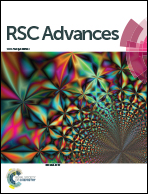Electrospinning preparation of a H4SiW12O40/polycaprolactam composite nanofibrous membrane and its greatly enhanced photocatalytic activity and mechanism†
Abstract
H4SiW12O40/polycaprolactam (PA6) composite nanofibrous membranes with a minimum average diameter of ∼70 nm were prepared by an electrospinning technique. Characterization with Fourier transform infrared spectroscopy (FT-IR), energy-dispersive X-ray spectroscopy (EDX) and X-ray photoelectron spectroscopy (XPS) indicated that H4SiW12O40 has been successfully loaded into the PA6 membrane and its Keggin structure was intact. The as-prepared H4SiW12O40/PA6 membranes exhibited greatly enhanced photocatalytic efficiency (≥96.0%) and excellent reusability in the degradation of methyl orange (MO) under ultraviolet irradiation, which may be attributed to the synergistic effect of PA6 and H4SiW12O40. The photocatalytic process was likely to be driven by the reductive pathway with a much faster degradation rate due to the electron donation from PA6 to H4SiW12O40. The hydrogen bonds between H4SiW12O40 and PA6 could enhance the stability of H4SiW12O40 in the membrane, so that there was nearly no loss of photocatalytic activity of the catalyst after three cycles of reactions. In view of this, H4SiW12O40/PA6 composite nanofibrous membranes exhibit potential for practical applications to eliminate organic pollutants from wastewater.



 Please wait while we load your content...
Please wait while we load your content...